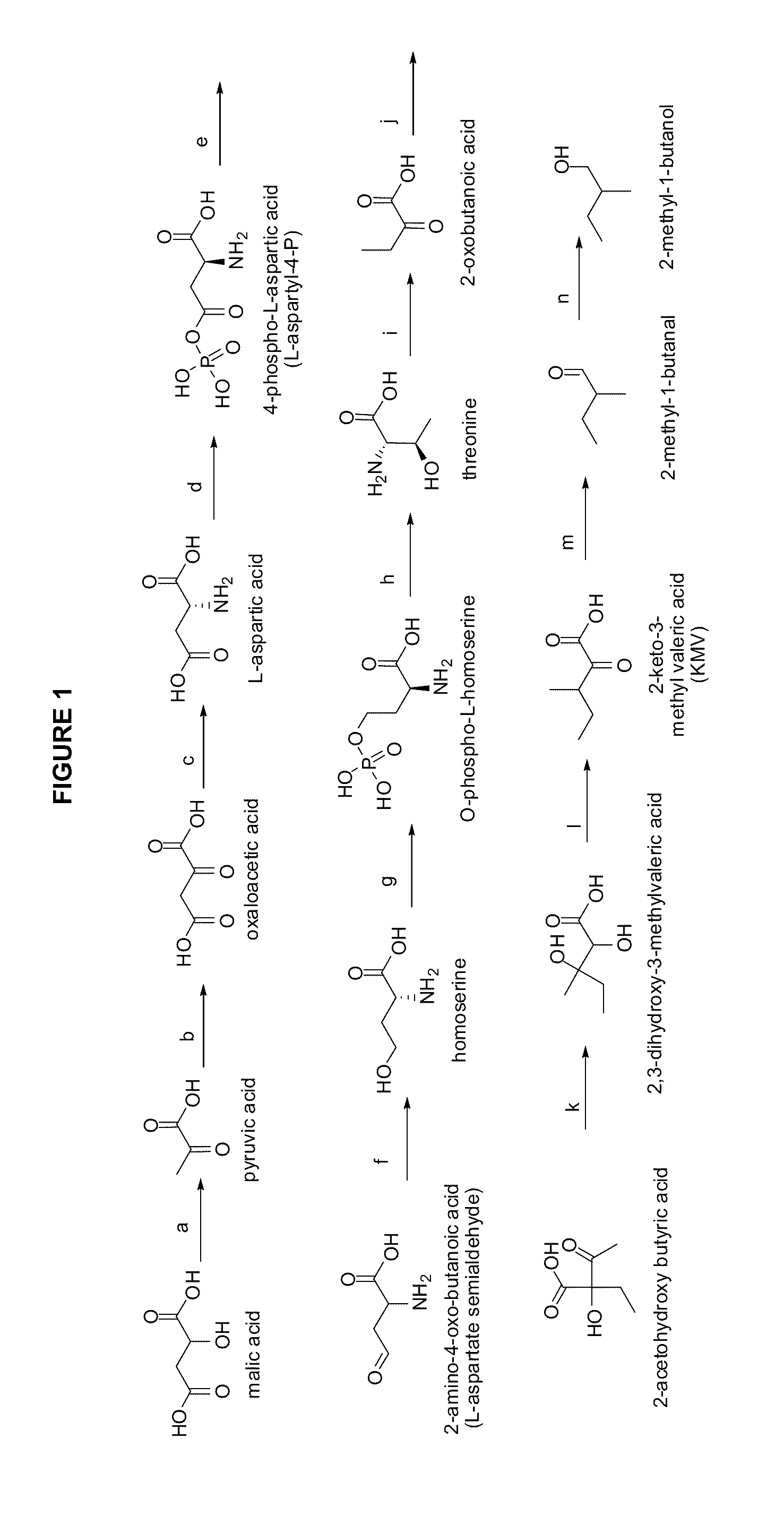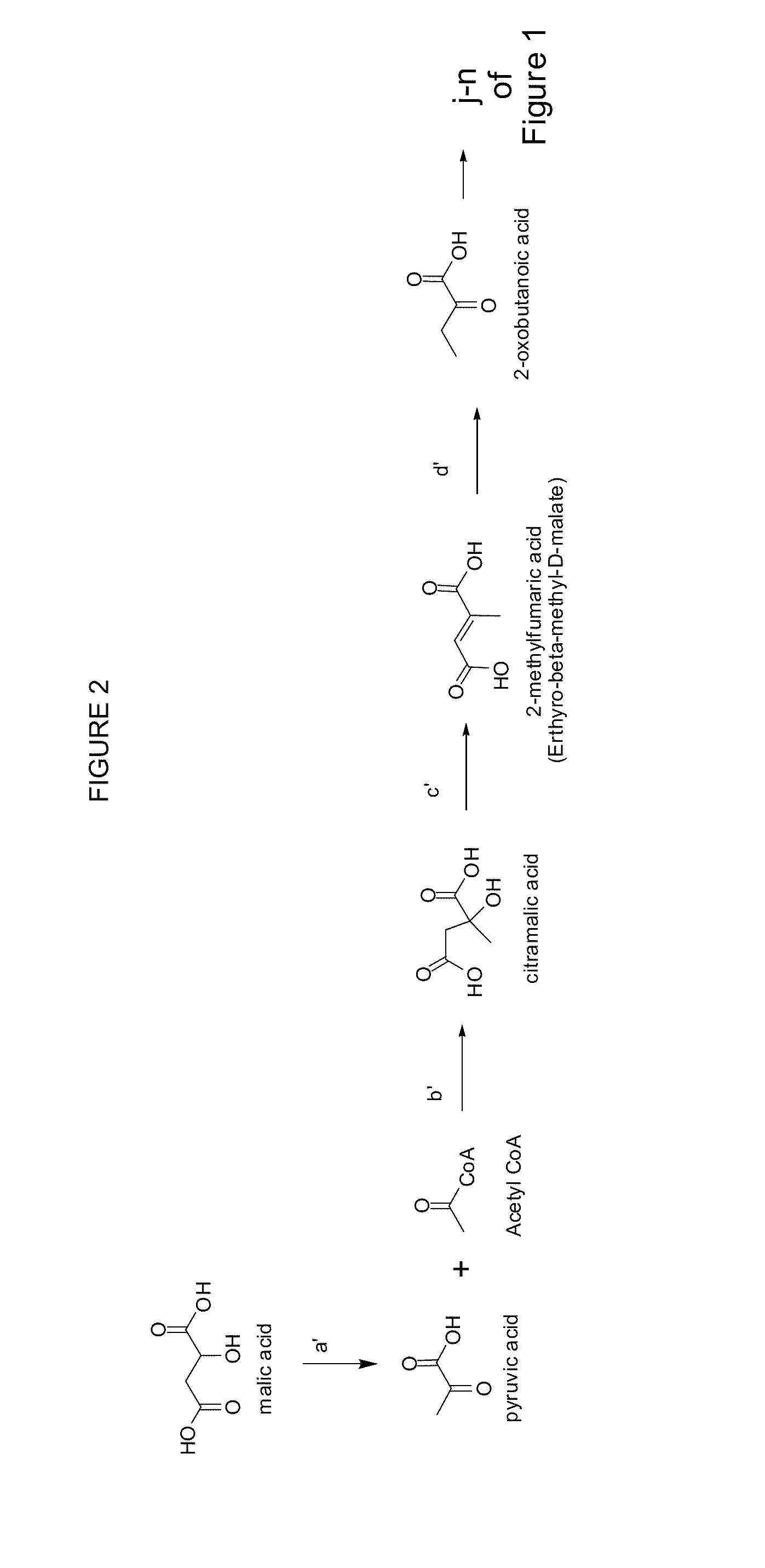Methylbutanol as an advanced biofuel
a biofuel and methylbutanol technology, applied in the field of gene expression, polypeptides and expression constructs, can solve the problem of increasing the cost of blended fuels
- Summary
- Abstract
- Description
- Claims
- Application Information
AI Technical Summary
Benefits of technology
Problems solved by technology
Method used
Image
Examples
example 1
Increase of Intracellular Threonine
[0384]As series of genes encoding enzymes from glucose to threonine were cloned from Saccharomyces cerevisiae and Pichia stipitis. These genes were tested for functional activity, either by enzyme assay or complementation of deletion mutations in Saccharomyces cerevisiae and profiling of intracellular amino acids.
[0385]Below are a series of experiments that highlight genes required for elevated threonine production FIGS. 6 through 16 show amino acid production by the overexpression of pathway genes in particular deletion backgrounds.
Amino Acid Analysis of MDH2 (7432), THR1 (7239) and PCK1 (8110) Expressed from p415TEF in Strain 7123
[0386]The impact of various expression vectors encoding different genes of interest on amino acid levels was made. For this analysis, constructs containing the MDH2 (7432), THR1 (7239) and PCK1 (8110) genes on the p415TEF expression vector were introduced into host strain 7123 (ATCC 200869 (MATα ade2Δ::hisG his3Δ200 leu2...
example 2
Identification of Genes Relevant for Methylbutanol Production
[0395]The Saccharomyces cerevisiae deletion collection was analyze to ascertain which specific loci are relevant to 2-MBO production. Various strains designated by their gene deletion using nomenclature consistent with the Saccharomyces Genome Database project were transformed with p415TEF-ILV1FBR and the control empty vector p415TEF. FIGS. 17 and 18 show the production of 2-MBO, while FIG. 19 shows the corresponding production of 3-MBO. The table below shows data relating to the production of 2-MBO in HOM3FBR: TEF ILV1FBR host strain with the addition of key genes in the pyruvate to threonine pathway.
2-MBOStrainGenotype(μM)8102TEF HOM3FBR: TEF ILV1FBR p413TEF-PCK (Ps)427.49p415TEF-THR1 (Ps) p416TEF-MDH2 (Ps)8103TEF HOM3FBR: TEF ILV1FBR p413TEF-PCK (Ps)405.55p415TEF-HOM6 (Ps) p416TEF-PYC (Ps)8104TEF HOM3FBR: TEF ILV1FBR p413TEF-PCK (Ps)1441.41p415TEF-HOM6 (Ps) p416TEF-MDH2 (Ps)8105TEF HOM3FBR: TEF ILV1FBR 1FBR p413TEF-PCK ...
example 3
Identification and Modification of Genes Relevant for Methylbutanol Production
[0396]Elevated intracellular pools of threonine accumulate in the cytoplasm of S. cerevisiae. The deamination of threonine is carried out by two enzymes; a catabolic threonine dehydratase (CHA1; FIG. 20) and a mitochondrial threonine deaminase (ILV1; FIG. 21). Experimental evidence has shown that overexpression of either of these enzymes results in increase production of 2-methylbutanol (2-MBO) in the growth medium. The production of 2-MBO can be further elevated by the modification of amino acid sequence ILV1 that are thought to be involved in the binding of isoleucine and create a feedback mechanism to shut down the pathway when intracellular amounts of isoleucine are in excess. The committed steps to isoleucine production and the conversion of threonine take place in the mitochondria. The key enzymes in the pathway (threonine deaminase, acetolactate synthase, acetohydroxyacid reductoisomerase and dihydr...
PUM
| Property | Measurement | Unit |
|---|---|---|
| ketol-acid | aaaaa | aaaaa |
| ketol-acid | aaaaa | aaaaa |
| weight | aaaaa | aaaaa |
Abstract
Description
Claims
Application Information
 Login to View More
Login to View More - R&D
- Intellectual Property
- Life Sciences
- Materials
- Tech Scout
- Unparalleled Data Quality
- Higher Quality Content
- 60% Fewer Hallucinations
Browse by: Latest US Patents, China's latest patents, Technical Efficacy Thesaurus, Application Domain, Technology Topic, Popular Technical Reports.
© 2025 PatSnap. All rights reserved.Legal|Privacy policy|Modern Slavery Act Transparency Statement|Sitemap|About US| Contact US: help@patsnap.com



